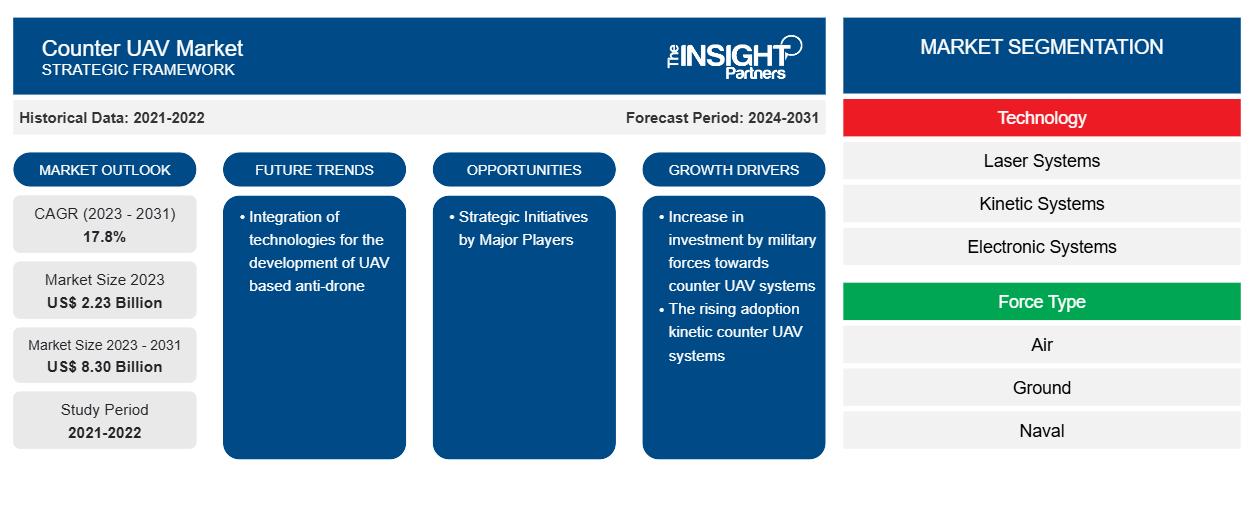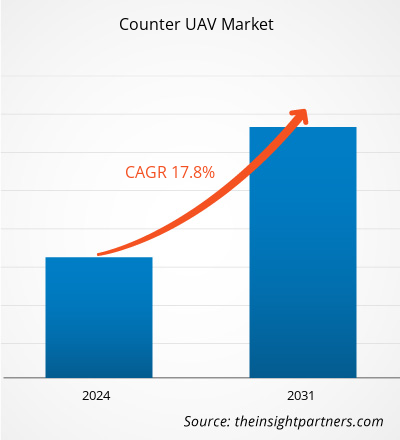The counter UAV market size is projected to reach US$ 8.30 billion by 2031 from US$ 2.23 billion in 2023. The market is expected to register a CAGR of 17.8% during 2023–2031. Integration of technologies for the development of UAV based anti-drone systems is likely to remain a key trend in the market.
Counter UAV Market Analysis
Lockheed Martin Corporation, Thales Group, Northrop Grumman Corporation, Leonardo SpA, and Rafael Advanced Defense Systems Ltd, are among the key market players operating in the global counter UAV market. The key players are listed by considering factors such as overall revenue, current counter UAV product portfolio, geographical reach, market initiatives, investment in technology upgrades, partnerships, and other market-related activities.
Counter UAV Market Overview
The major stakeholders in the global counter UAV market ecosystem include component manufacturers, system integrators, and end-users amongst others. A counter UAV system radar is made up of various components such as sensors, and GPS systems which are procured by the system manufacturers from a huge base of component manufacturers. These component manufacturers supply the base parts to the global counter UAV market players. The system integrators are the companies that are engaged in manufacturing the anti-drone systems after integrating each component. Some of the major players operating in the market include the market include Raytheon Technologies Corporation, Rafael Advanced Defense Systems Ltd., Thales Group, Lockheed Martin Corporation, and Israel Aerospace Industries Ltd. among others. The end-user of the global counter UAV market includes air, land, and naval forces that are engaged in defense and homeland security of the countries. The counter UAV solutions have also experienced a rise in adoption by homeland security forces for private global events and concerts. Thus, the rise in military expenditure by developed and developing nations and their rising investments to ensure safety from both land and costal borders from hostile drones is also propelling the high adoption of counter UAV solutions across the globe.
Customize This Report To Suit Your Requirement
You will get customization on any report - free of charge - including parts of this report, or country-level analysis, Excel Data pack, as well as avail great offers and discounts for start-ups & universities
Counter UAV Market: Strategic Insights

-
Get Top Key Market Trends of this report.This FREE sample will include data analysis, ranging from market trends to estimates and forecasts.
Counter UAV Market Drivers and Opportunities
Rising Adoption Kinetic Counter UAV Systems
Kinetic counter UAV systems are used by military bodies across the globe to completely take down a drone. It utilizes anti drone weight lines or nets which is generally launched with the help of compressed air, or another UAV. These devices help to capture the drone, neutralize it or destroy the same. Some time, unknown drones are sent within military boundaries to study the area or to keep a close eye to the opponents where-abouts. In such cases, destroying the complete drone ensures enhanced safety to the military forces.
Some of the major companies offer kinetic counter UAV systems include KWESST Micro Systems Inc. and Zen Technologies Limited amongst others. KWESST Micro Systems Inc., offers micro-drone for kinetic interdiction of small drones, including swarms, that can be launched by soldiers. It is a fully automatic drone which helps in the dentification of drones, track, hunt and neutralize them with kinetic technology. These systems also cover a range of 4km. The company in October 2021, announced the development of new counter UAV system in response to the rapidly increasing threat of loitering munitions.
Strategic Initiatives by Major Players
The rising terrorist attacks and political instability among various developed and developing countries is increasing the defense and homeland security forces to increase their procurement of advanced solutions such as radar systems, communication systems and anti-drone technologies amongst others. For instance, department of defense of US, European Union and other authorities like Indian defense ministry has increased their spending on procurement of anti-drones over the years. This is leading the counter UAV manufacturers to adopt organic and inorganic growth strategies, such as high investments, product offerings, and global expansion, further creating growth opportunities for the global counter UAV market.
Counter UAV Market Report Segmentation Analysis
Key segments that contributed to the derivation of the counter UAV market analysis are technology, force type, product type, configuration, and end users.
- Based on technology, the counter UAV market is segmented into laser systems, kinetic systems, and electronic systems. The electronic systems segment held a larger market share in 2023.
- Based on force type, the counter UAV market is segmented into air, ground, and naval. The ground segment held a larger market share in 2023.
- Based on product type, the counter UAV market is segmented into ground based and handheld. The ground-based segment held a larger market share in 2023.
- Based on configuration, the counter UAV market is bifurcated into portable and stationary. The stationary segment held a larger market share in 2023.
- Based on configuration, the counter UAV market is categorised into defense and homeland security. The defense segment held a larger market share in 2023.
Counter UAV Market Share Analysis by Geography
The geographic scope of the counter UAV market report is mainly divided into four regions: North America, Europe, Asia Pacific, and Rest of the World.
North America has dominated the market in 2023 followed by Europe and Asia Pacific regions. Further, Asia Pacific is also likely to witness highest CAGR in the coming years. The US accounted for major share in the North American counter UAV market. The anti UAV systems, according to the US Department of Defense (DOD), helps the US army to detect and neutralize hostile or attacking drones. Due to their size, construction material, and flight altitude, many smaller UASs are undetectable by typical air defence systems. As a result, the US Department of Defense (DOD) expects to spend at least US$ 636 million on counter-UAS (C-UAS) research and development in FY2022, as well as at least US$ 75 million on C-UAS procurement, a US$ 134 million increase over FY2021. As the US DoD continues to develop, purchase, and deploy these technologies, contributing to the market's growth.
Counter UAV Market Regional Insights
The regional trends and factors influencing the Counter UAV Market throughout the forecast period have been thoroughly explained by the analysts at The Insight Partners. This section also discusses Counter UAV Market segments and geography across North America, Europe, Asia Pacific, Middle East and Africa, and South and Central America.
Counter UAV Market Report Scope
| Report Attribute | Details |
|---|---|
| Market size in 2023 | US$ 2.23 Billion |
| Market Size by 2031 | US$ 8.30 Billion |
| Global CAGR (2023 - 2031) | 17.8% |
| Historical Data | 2021-2022 |
| Forecast period | 2024-2031 |
| Segments Covered |
By Technology
|
| Regions and Countries Covered |
North America
|
| Market leaders and key company profiles |
|
Counter UAV Market Players Density: Understanding Its Impact on Business Dynamics
The Counter UAV Market is growing rapidly, driven by increasing end-user demand due to factors such as evolving consumer preferences, technological advancements, and greater awareness of the product's benefits. As demand rises, businesses are expanding their offerings, innovating to meet consumer needs, and capitalizing on emerging trends, which further fuels market growth.

- Get the Counter UAV Market top key players overview
Counter UAV Market News and Recent Developments
The counter UAV market is evaluated by gathering qualitative and quantitative data post primary and secondary research, which includes important corporate publications, association data, and databases. A few of the developments in the counter UAV market are listed below:
- Elbit Systems is unveiling a new and unique Electronic Warfare (EW) capability at the Paris Airshow as part of its Unified EW suite. The new capability is provided via the digital Radar Warning Receivers (RWR), one part of Elbit’s proven Airborne self-protection EW suite, and enables drone detection and identification as well as locating Personal Location Beacon (PLB) of ground forces and pilots. (Source: Elbit Systems Ltd, Press Release, Jun 2023)
- Elbit Systems Ltd (NASDAQ:ESLT and TASE: ESLT) Elbit Systems announced today that it was awarded a contract worth approximately $55 million to supply multi-layered ReDrone Counter Unmanned Aerial Systems (C-UAS) to the Netherlands. The contract will be performed over a period of four years. (Source: Elbit Systems Ltd, Press Release, Aug 2023)
Counter UAV Market Report Coverage and Deliverables
The “Counter UAV Market Size and Forecast (2021–2031)” report provides a detailed analysis of the market covering below areas:
- Counter UAV market size and forecast at global, regional, and country levels for all the key market segments covered under the scope
- Counter UAV market trends as well as market dynamics such as drivers, restraints, and key opportunities
- Detailed porter’s five forces analysis
- Counter UAV market analysis covering key market trends, global and regional framework, major players, regulations, and recent market developments
- Industry landscape and competition analysis covering market concentration, heat map analysis, prominent players, and recent developments for the counter UAV market
- Detailed company profiles
Frequently Asked Questions
Which region dominated the counter UAV market in 2023?
What are the driving factors impacting the counter UAV market?
What are the future trends of the counter UAV market?
Which are the leading players operating in the counter UAV market?
What would be the estimated value of the counter UAV market by 2031?
What is the expected CAGR of the counter UAV market?
- Historical Analysis (2 Years), Base Year, Forecast (7 Years) with CAGR
- PEST and SWOT Analysis
- Market Size Value / Volume - Global, Regional, Country
- Industry and Competitive Landscape
- Excel Dataset
Recent Reports
Testimonials
Reason to Buy
- Informed Decision-Making
- Understanding Market Dynamics
- Competitive Analysis
- Identifying Emerging Markets
- Customer Insights
- Market Forecasts
- Risk Mitigation
- Boosting Operational Efficiency
- Strategic Planning
- Investment Justification
- Tracking Industry Innovations
- Aligning with Regulatory Trends





















 Get Free Sample For
Get Free Sample For